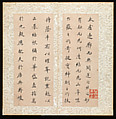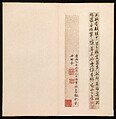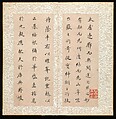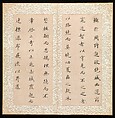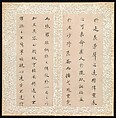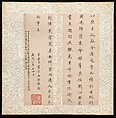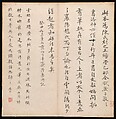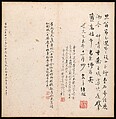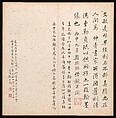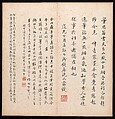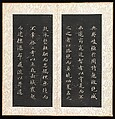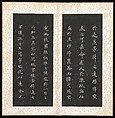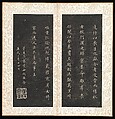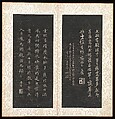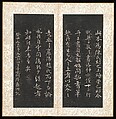Returned to lender The Met accepts temporary loans of art both for short-term exhibitions and for long-term display in its galleries.
Two Prose Poems:"Mt. Tiantai" and "Parrot"
Dong Qichang Chinese
Not on view
明 董其昌 小楷天台鸚鵡二賦 冊 紙本
The seventeenth-century interest in eccentricity and innovation was in part a reaction to Dong Qichang achievements, which took the elegance of the classical tradition to such heights that some felt there was nothing left to achieve. These albums capture Dong’s understated sophistication as well as his somewhat regimented style. The characters are arranged meticulously into rail-straight columns of twelve. The structures of the characters themselves are supremely balanced between top and bottom, left and right. The brushwork is precise yet fluid. The ink, rich but with a hint of tonal variation and transparency, is of the highest quality.
Displayed here are pages from two separate but related albums: one is handwritten by Dong Qichang and the other is a rubbing taken from it. Studying the work of great calligraphers, both past and present, was of critical importance in learning calligraphy. Since the majority of calligraphers did not have access to genuine works, they had to rely on other sources, such as rubbings. To create a rubbing, the original calligraphy was traced, then transferred and carved onto a stone or woodblock, from which many impressions could be made and studied. This technology also allowed calligraphers in pre-modern China to gain empire-wide fame in their own lifetime through reproductions of their work. Dong’s calligraphy consists of partial transcriptions of two rhymed prose poems entitled “Mt. Tiantai” and “ Parrot,” composed by Sun Chuo (314–371) and Mi Heng (173–198), respectively.
Due to rights restrictions, this image cannot be enlarged, viewed at full screen, or downloaded.
This artwork is meant to be viewed from right to left. Scroll left to view more.
